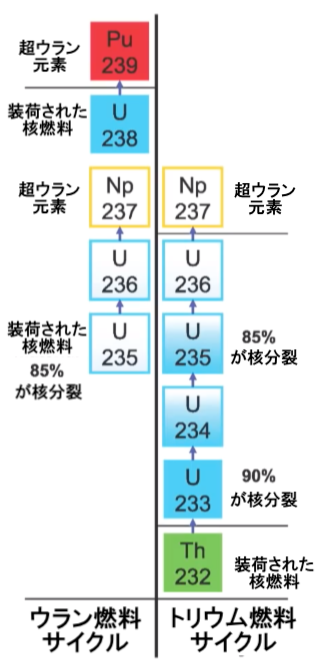Spent Nuclera Fuel
Processing of spent nuclear fuel
1. Do not generate unburned spent nuclear fuel
In light water reactors, a large amount of uranium-238 is mixed into the nuclear fuel to absorb excess neutrons in order to suppress the explosive chain reaction of nuclear fission like an atomic bomb. The rest will be spent nuclear fuel. On the other hand, the molten salt reactor operates continuously for a long time and burns up the nuclear fuel, so it does not generate a large amount of unburned spent nuclear fuel.
(The fuel salt in the reactor is periodically chemically treated to remove the fission products, and then returned to the reactor to continue burning.)
2. Produces almost no plutonium or transuranic elements

Uranium-238 used in light water reactors produces plutonium when it absorbs neutrons, and when it absorbs neutrons, it generates transuranium elements, which are heavier than plutonium. These transuranic elements have half-lives of tens of thousands of years, and it is difficult to continue to manage them for such a long period of time even if they are buried in geological formations, making the final disposal of spent nuclear fuel difficult.
On the other hand, in a thorium molten salt reactor, thorium-232 absorbs neutrons and burns most of it as nuclear fuel uranium-233 (or uranium-235), so plutonium and transuranic elements are hardly generated. Therefore, the amount of fission products that must be disposed of as spent nuclear fuel is small, and most of them have a short half-life of several hundred years at maximum, so the burden of spent nuclear fuel processing is extremely small.
3. Can reduce the volume of plutonium and MA
With molten salt, plutonium produced at existing nuclear power plants can be used as a fuel instead of U233, and can be burned more efficiently than bull thermals in light water reactors, resulting in volume reduction. In addition, fissionable isotopes of other transuranium elements can be used as fuel and can be reduced in volume.
